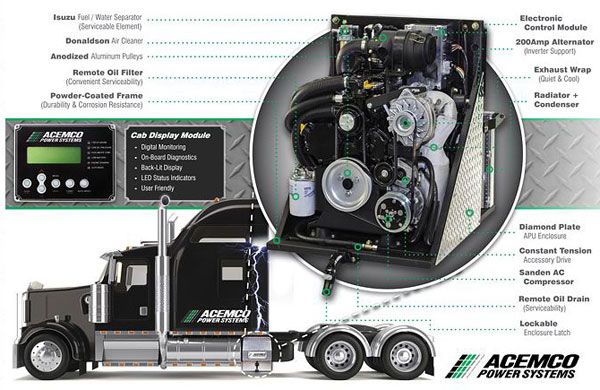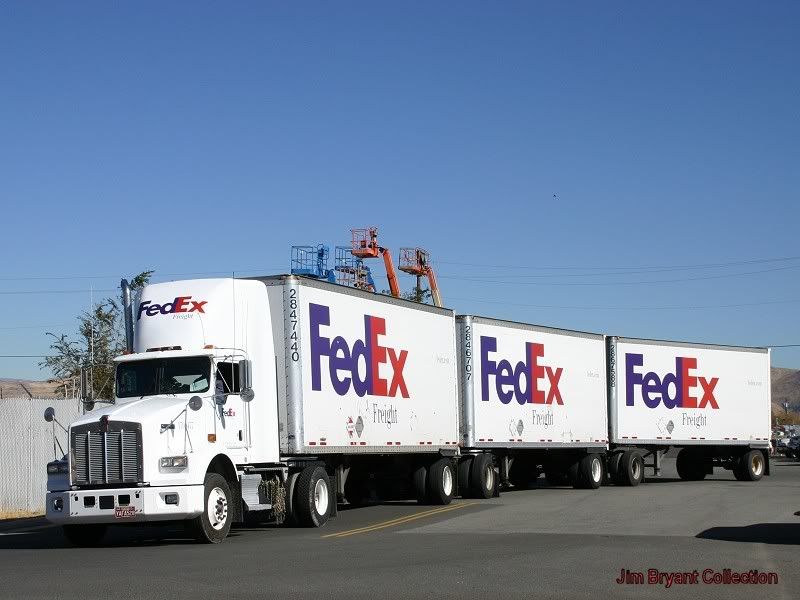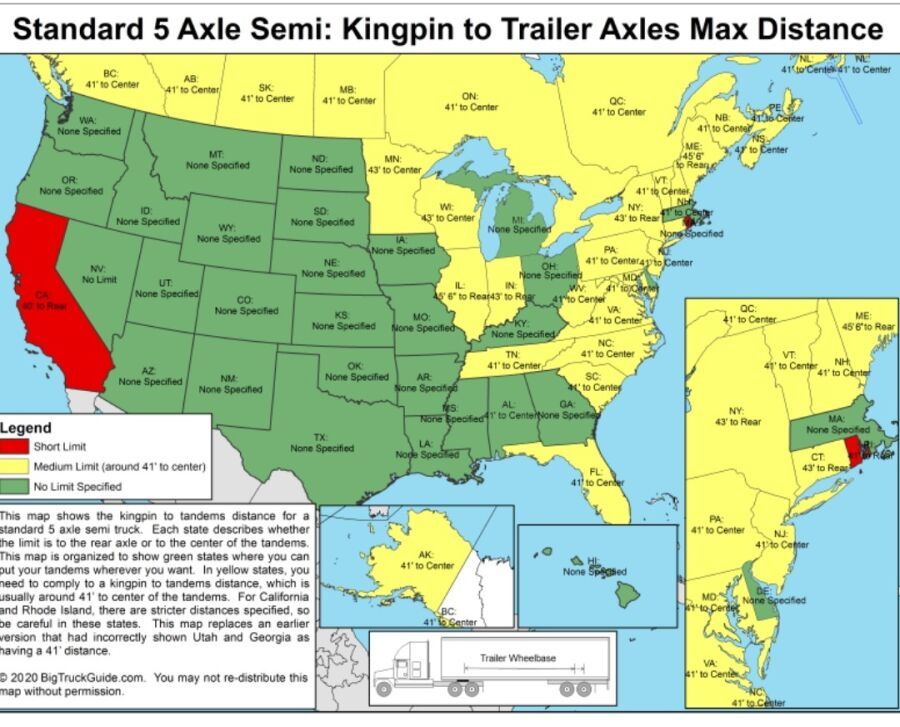Bad First Impression!
Topic 32032 | Page 3
Seriously . . if you'll kindly re read my question, is there a 'fine line?' A way to 'adjust/compensate?
Apologies, M'lady. It's been a long day. Even longer when you beat yourself up over things you should have done differently. I'm easygoing when it comes to others' mistakes. Very critical of my own.
Forgive me if I explain something you already know. Anyway. You asked if it could have been tweaked to make it legal. As in sliding the tandems back to take weight off those axles? Yes...to a certain extent. Many states have a limit to how far you can slide the tandems back. Virginia's law is that the maximum distance between the king pin and the point between the front and rear tandem axles can't exceed 41 feet. California in comparison allows only 40ft as measured from the king pin to the front tandem axle. Less room to play with there.
When I first crossed the scales I was given the opportunity to park and slide my tandems in order to make legal weight. The bad thing is that I only had about 4 holes to work with. Each hole on our trailers reduces the weight on the tandems by 500lbs and shifts that weight to the drive axles when the tandems are moved towards the rear of the trailer.
I was something like 3,000lbs overweight on my tandems when I first crossed the scale. After I slid the tandems back as far as legally possible in Virginia, I was still around 1,000lbs over the legal weight. There was no way to make it work.
I think you wanted to know, If I wasn't new to the company would I have taken my chances and ran with it. NO WAY. I already got a citation for it. Not going to make it any worse. I was able to drive it to another Saia facility in Virginia (I picked up in PA) to get the load "reworked".
This is perfect, RD. No apologies needed.. Yessir, I sure WAS trying to work it out in my cunning lil' head, thinking that an 'Old Hand' could make it work; APU deduction or something. Honestly, I don't even KNOW where I've 'learned' bad habits, sure wasn't Tom. I'm always trying to 'outsmart' something with numbers.
You're awesome, dude. Thank you tons for clarification. I'm so sorry you went through this. I just HATE defeat. I'll be letting go of some of my OWN stubbornness when it's my turn, I'm seeing.
It's huge that you've shared with us, the gang ... and the futures. (As my dumarske self wonders if it would work in Ohio!) I've got to lose some of my mathematical risque factoring. I know this. You synched it. No tweaking numbers in trucking. Good thing I don't do Vegas.
Thank you thank you and thanks again, for all the info you've provided to me, AND the many in the future! You'll have a company tab/tag on here shortly, so many may follow.
I'm so sorry you had this happen. Humility is a virtue worth possessing; perhaps the most important.
Get some rest; carry on, good sir.
~ Anne ~



Tandems:
Tandem Axles
A set of axles spaced close together, legally defined as more than 40 and less than 96 inches apart by the USDOT. Drivers tend to refer to the tandem axles on their trailer as just "tandems". You might hear a driver say, "I'm 400 pounds overweight on my tandems", referring to his trailer tandems, not his tractor tandems. Tractor tandems are generally just referred to as "drives" which is short for "drive axles".
Tandem:
Tandem Axles
A set of axles spaced close together, legally defined as more than 40 and less than 96 inches apart by the USDOT. Drivers tend to refer to the tandem axles on their trailer as just "tandems". You might hear a driver say, "I'm 400 pounds overweight on my tandems", referring to his trailer tandems, not his tractor tandems. Tractor tandems are generally just referred to as "drives" which is short for "drive axles".
HOS:
Hours Of Service
HOS refers to the logbook hours of service regulations.APU:
Auxiliary Power Unit
On tractor trailers, and APU is a small diesel engine that powers a heat and air conditioning unit while charging the truck's main batteries at the same time. This allows the driver to remain comfortable in the cab and have access to electric power without running the main truck engine.
Having an APU helps save money in fuel costs and saves wear and tear on the main engine, though they tend to be expensive to install and maintain. Therefore only a very small percentage of the trucks on the road today come equipped with an APU.


A note on "fault". If fault means, "who initially screwed things up" then Bruce is correct that the shipper is at fault for loading the trailer in such an irresponsible way. I appreciate Bruce's statement as a show of support for a fellow driver.
If fault means, "who is ultimately responsible" then Bird-one is correct...I'm at fault.
Thanks to G-Town for supplying the word, "responsible" (and his kind words) to help make things clearer. And to Bird-one for further clarifying what he meant. Semantics is a pain in the butt sometimes.
Auggie, the fine was $184. The officer at the weigh station said that the fine was not mine. It is the company's, and they are the ones responsible for paying it. However, I may have signed something during orientation that said I'd liable for any fines I receive while operating a company vehicle. Not 100% sure about that. Haven't been told I'm responsible for it yet. I'll find out soon enough.
$184 for 1,000? Ouch. Hopefully you won't have to pickup the tab.
Shipper:
The customer who is shipping the freight. This is where the driver will pick up a load and then deliver it to the receiver or consignee.
RD that is hard situation for sure. I always hated picking up preloaded sealed loads, espically when no scale is close.
My guess is here you were so used to having tools at Prime that made your job easier, you may have gotten a tad complacient and seeing the gross weight assumed all was good. Not judging what you did, but we all can get complacient espically after lenghtly periods of dealing with good folks who generally always do things right.
Different companies handle these things differently. RD I would highly recommend you finding out if you signed something during orientation making you responsible. For new drivers reading this… Always read and understand any document before you sign it.
Just yesterday I picked up a load that was loaded completely wrong from start to finish. Bottom line I got people involved to help me and we reworked the load to make it right. Took 3 hrs. These same folks normally load correctly, but it was this one time they really messed it up. Alot easier to notice on a flatbed.
This is a good discussion and info.
I decided to scale my current load after thinking about it. The numbers were not adding up.
My Right Weigh numbers were: Drives 32k and Trailer 30.5k. The shipper claimed on the BOL to have loaded 47.3k of freight “subject to correction”. If that was correct, then my gross weight should be 77.3k to 79.8k. I’m not 100% sure what my tractor + empty trailer weigh. I think it is between 30.5k and 32k. I’ll make a point to weigh it empty when I get a chance.
Anyway, the CAT scale weights are: Steers 11,800; Drives 31,520; Trailer 30,920; Gross 74,240. The tandem is in the 6th hole for CA. My fuel gauge was at 1/2+.
It appears that the shipper over estimated the weight of their freight by 3-5k lbs.
Shipper:
The customer who is shipping the freight. This is where the driver will pick up a load and then deliver it to the receiver or consignee.
Tandem:
Tandem Axles
A set of axles spaced close together, legally defined as more than 40 and less than 96 inches apart by the USDOT. Drivers tend to refer to the tandem axles on their trailer as just "tandems". You might hear a driver say, "I'm 400 pounds overweight on my tandems", referring to his trailer tandems, not his tractor tandems. Tractor tandems are generally just referred to as "drives" which is short for "drive axles".
CAT Scale:
A network of over 1,500 certified truck scales across the U.S. and Canada found primarily at truck stops. CAT scales are by far the most trustworthy scales out there.
In fact, CAT Scale offers an unconditional Guarantee:
“If you get an overweight fine from the state after our scale showed your legal, we will immediately check our scale. If our scale is wrong, we will reimburse you for the fine. If our scale is correct, a representative of CAT Scale Company will appear in court with the driver as a witness”
CORRECTION: California measures from king pin to rear axle.
The photo might be hard to view. May have to open it in another page to zoom in.

Auggie, my fine was based on the weight I originally rolled onto the scale at. Not based on my second time through after I adjusted the tandems. Plus they added a $25 civil penalty and a $20 processing fee.
you may have gotten a tad complacient and seeing the gross weight assumed all was good. Not judging what you did...
It's all good. Complacency is the enemy for sure😉
Tandems:
Tandem Axles
A set of axles spaced close together, legally defined as more than 40 and less than 96 inches apart by the USDOT. Drivers tend to refer to the tandem axles on their trailer as just "tandems". You might hear a driver say, "I'm 400 pounds overweight on my tandems", referring to his trailer tandems, not his tractor tandems. Tractor tandems are generally just referred to as "drives" which is short for "drive axles".
Tandem:
Tandem Axles
A set of axles spaced close together, legally defined as more than 40 and less than 96 inches apart by the USDOT. Drivers tend to refer to the tandem axles on their trailer as just "tandems". You might hear a driver say, "I'm 400 pounds overweight on my tandems", referring to his trailer tandems, not his tractor tandems. Tractor tandems are generally just referred to as "drives" which is short for "drive axles".
RD, I mentioned that I had a similar experience to yours. I had trouble with a load 3 years ago. Only driving for about 2 months. Picked up a live load at P&G and weighed it. Overweight. Return to P&G for a re-work. Back to scale. Slightly overweight on trailer tandems. Slide tandems back several holes, re-weigh and everything is fine. EXCEPT now my tandems are too far back for the law. I get pulled in, and am issued a citation. The trooper told me that their law or regulation prohibited the driver from paying the fine (somewhere in the neighborhood of $300). The company was obligated to pay. I turned the citation into the company (Schneider), and they told me I had to pay the fine. I told the guy from the citation department that the company was required to pay the fine. He said he’d doubted it, but he would check it out. I never heard another word about it.
Like G-Town correctly points out, it was my responsibility. But I learned from it and haven’t made the same mistake again.
Tandems:
Tandem Axles
A set of axles spaced close together, legally defined as more than 40 and less than 96 inches apart by the USDOT. Drivers tend to refer to the tandem axles on their trailer as just "tandems". You might hear a driver say, "I'm 400 pounds overweight on my tandems", referring to his trailer tandems, not his tractor tandems. Tractor tandems are generally just referred to as "drives" which is short for "drive axles".
Tandem:
Tandem Axles
A set of axles spaced close together, legally defined as more than 40 and less than 96 inches apart by the USDOT. Drivers tend to refer to the tandem axles on their trailer as just "tandems". You might hear a driver say, "I'm 400 pounds overweight on my tandems", referring to his trailer tandems, not his tractor tandems. Tractor tandems are generally just referred to as "drives" which is short for "drive axles".
I loved the gauge for 5th wheel weight psi anything around or under 60 psi, was good. Only got a ticket in Idaho Scale on I-80 for 4,000 over. Lady let me adjust tandems , re-scale, still over,reset further back, re-scale said I was legal "now" said they probably put too much on the back end.
Still had to pay $225 fine or come back and go to court she said lol. Like, ma'am, I'm not coming back thru this damn state again! Was with CRST, never "assumed" again after that mess and $$ loss.... Yeah I got lazy or whatever, usually we'd scale at the shippers, if possible, or nearest Love's, and used tire pass for EVERY trailer we pulled !
Shipper:
The customer who is shipping the freight. This is where the driver will pick up a load and then deliver it to the receiver or consignee.
Tandems:
Tandem Axles
A set of axles spaced close together, legally defined as more than 40 and less than 96 inches apart by the USDOT. Drivers tend to refer to the tandem axles on their trailer as just "tandems". You might hear a driver say, "I'm 400 pounds overweight on my tandems", referring to his trailer tandems, not his tractor tandems. Tractor tandems are generally just referred to as "drives" which is short for "drive axles".
Tandem:
Tandem Axles
A set of axles spaced close together, legally defined as more than 40 and less than 96 inches apart by the USDOT. Drivers tend to refer to the tandem axles on their trailer as just "tandems". You might hear a driver say, "I'm 400 pounds overweight on my tandems", referring to his trailer tandems, not his tractor tandems. Tractor tandems are generally just referred to as "drives" which is short for "drive axles".
Only got a ticket in Idaho Scale on I-80 for 4,000 over.
Stevo,
Yeah, you won't be in Idaho ever again if you go 80 😉😁😂 No I-80 in Idihoho, only 84. I live near 84.
My brother opted not to weigh his load of liquid citric acid (in totes) and got pulled in at the weigh station by Boise. He was 2,000 lb over on his drives. He was able to make it good but still received a ticket for $84. He could have gone back to court since he was living at my house, but just opted to pay for it since it was a reasonable amount.
Laura
DUHHH My bad Ms. Ida-Who lol , was I-84
New Reply:
New! Check out our help videos for a better understanding of our forum features

















Preview:
This topic has the following tags:
Choosing A Trucking Company Hard Lessons Learned Truck Driving Orientation Truck Driving Stories Weight and Scales







 TT On Facebook
TT On Facebook
A note on "fault". If fault means, "who initially screwed things up" then Bruce is correct that the shipper is at fault for loading the trailer in such an irresponsible way. I appreciate Bruce's statement as a show of support for a fellow driver.
If fault means, "who is ultimately responsible" then Bird-one is correct...I'm at fault.
Thanks to G-Town for supplying the word, "responsible" (and his kind words) to help make things clearer. And to Bird-one for further clarifying what he meant. Semantics is a pain in the butt sometimes.
Auggie, the fine was $184. The officer at the weigh station said that the fine was not mine. It is the company's, and they are the ones responsible for paying it. However, I may have signed something during orientation that said I'd liable for any fines I receive while operating a company vehicle. Not 100% sure about that. Haven't been told I'm responsible for it yet. I'll find out soon enough.
Shipper:
The customer who is shipping the freight. This is where the driver will pick up a load and then deliver it to the receiver or consignee.